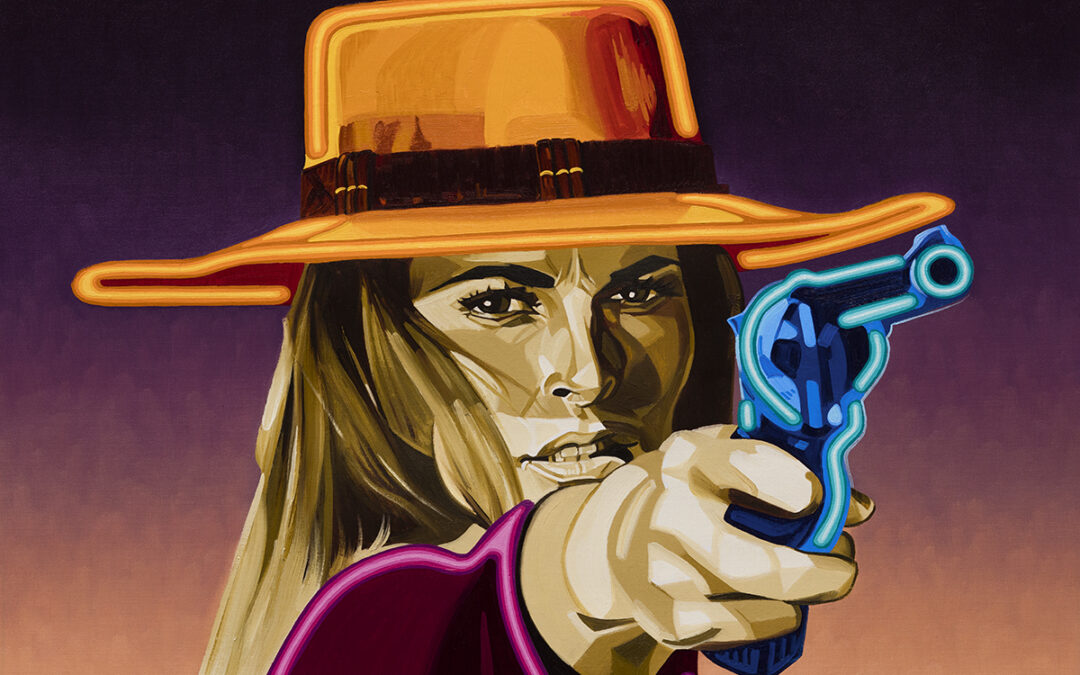Listen to the full podcast episode here or wherever you stream your podcasts!
Has the whiff of a scent ever transported you to another time or place? For artist Michael Blessing, a similar thing happens when he sees color. The only difference is that instead of a memory, color makes Michael hear music.
Michael grew up playing the trombone and drums, but also drawing and painting. Both forms of expression earning equal time, that is until a middle school teacher stopped Michael in the hall of the school and told him he better not show up in his art class the following year. Micahel was stunned and didn’t know what to say. Instead, he decided to solely focus on his music.
Michael went on to college and earned a degree in music and performance and went on to open his own recording studio. He produced music and played jazz for years until one afternoon when a recording artist who’d booked two months with him called to tell him she needed to back out.
Life’s Twists and Turns
That two month booking was with recording artist, Jenn Adams, who’d canceled because of an opportunity in Nashville. Michael, being the extremely kind hearted person that he is, was thrilled for her and instead saw this as an opportunity to get back into drawing.
He started drawing out small still lifes from around the house, his then wife and daughter were flabbergasted. They had no idea that Michael had such an extraordinary hidden talent. It started to become a game for his daughter to find a random object or one of her toys from around the house to bring to him to draw with such precision in detail.
If you were to ask Michael the relationship between his life as a music producer and his life as a visual artist, I would tell you to buckle up because you are going on an adventure! Diving into the history of the harmonic scale and what is considered the “perfect pitch”, we are zoomed back to World War II. Pre-war the general idea for orchestras was to play at the pitch level of 432 hertz which is often associated with the sounds of nature, the same pitch you might hear a dog howl or a hawk screech. Post-war, due to the time of turmoil, orchestras were told to play at a pitch level of 440 hertz which is considered jagged and angry, in comparison.
Fine Line Between Sound and Sight
As Michael delves into the world of tri-chords, Dmitri Shostakovich, and the propaganda statement of Pablo Picasso’s La Guernica, you can see the genuine excitement, and dare I say the nerd out, of the history of music and art. Both with the power to evoke intense emotions, which is evident in the way that Michael swings his arms and hands in animated gestures talking about sacred geometry and how images form in his head from music around him.
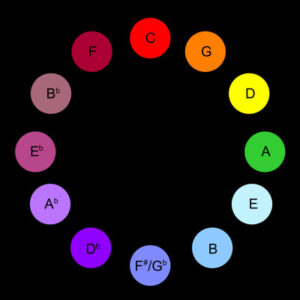
The Scriabin Circle
When Michael creates a new work of art, he focuses on the vibrations of colors, almost as if composing a symphony as he paints to evoke the sounds within the colors. Talking about a specific piece in the gallery, “Head Fake”, which is a full figure portrait of Elsa Martinelli from the film The Belle Starr Story, he explains the different sounds in the colors of her neon shoes and pants. The yellow-green of her shoes, Michael’s favorite color, gives off an intense bright color, just like the bright intense sound of a piccolo trumpet. The purple violet of her pants makes the sound of a G flat or an F sharp as it bounces off the canvas.
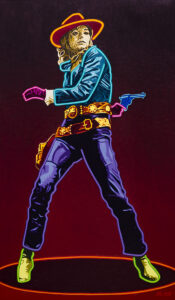
Head Fake, Michael Blessing, oil on linen
Hanging nearby is a, what you might assume, black and white photograph of a skull by Jeff Puckett, but to Michael the rich, deep tone of the black is like falling into a deep drum or double bass. Michael Blessing is a man who doesn’t see the world, but rather hears it through color.
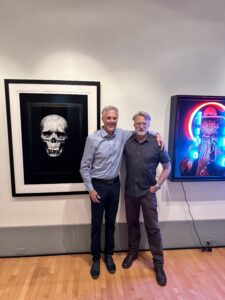
(Left to right) Jeff Puckett and Michael Blessing standing between their two artworks, featuring the Skull photography Michael talks about
Journey from Portrait to Neon
With such a scientific mind, how did Michael go from doodling still life’s of his daughter’s toys to the neon portrait masterpieces hanging in the gallery today? By 2004 Michael was already showing in galleries and taking workshops from artists like Peggi Kroll, but with the 2008 stock market changes he put his painting away for 3 years and did some audio teaching. It would be around this time Michael would meet his now wife, Meagan, a fellow artist, and would bring him back to the world of visual art.
Inspired by Wayne Theibauld, Michael would learn to love figure painting and doing portraits. However, he still needed to meet the demands of work and would paint neon signs, which you would often find in what Michael describes as the “dark, dank corners” of shows. One day a man saw one of these neon pieces and bought with the intention of representing Michael which led to him breaking a sale record at the Russell Auction. Michael was up to creating 85 paintings a year.
With the high demand of these Americana paintings, and the lingering passion for portraits, it was like a neon LED light bulb went off in his head. What would it be like if he added the neon to the figures? As his Neon West series has grown and become more popular he has also started experimenting with adding the actual neon light to the figures.
Myth of the West
As his career expands, Michael’s artwork on the surface is innately “Western”. The spaghetti western characters, so named because they were ironically filmed in Italy but distinctly depicted the American West, show neither truth nor lies, just an interpretation of the West. Always moving and changing, Michael is now starting to take these neon ideas and translating them into landscapes, creating a dreamscape from a real place. Another interpretation that is neither truth nor lie.
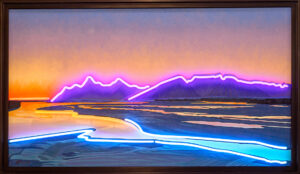
Stillness at Twilight, Michael Blessing, mixed media
Learn more about Michael’s journey with music and art on his blog!
Listen to the full podcast episode here or wherever you stream your podcasts!

